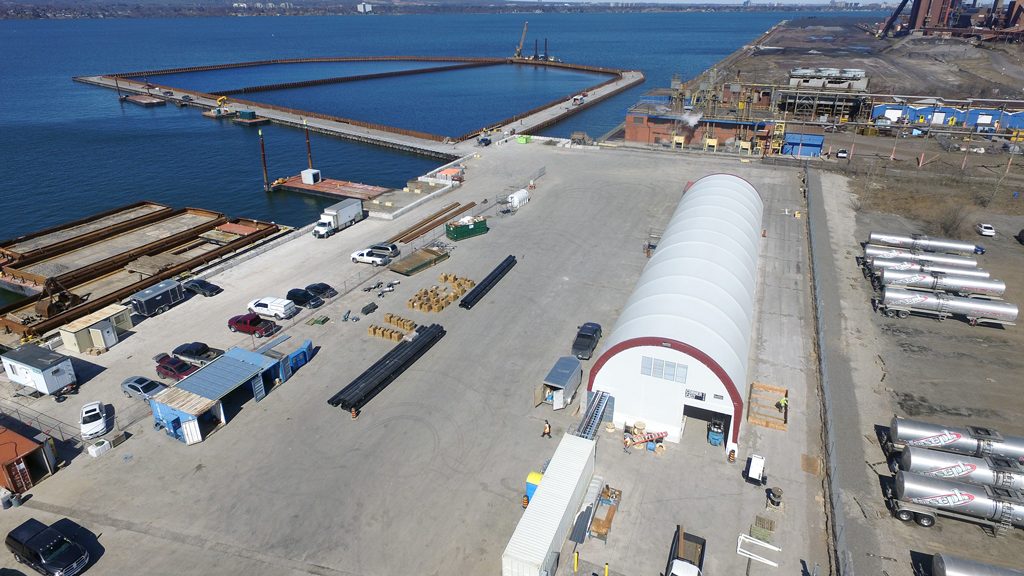Hamilton, Ont.’s massive harbour cleanup project will move into a second phase this July as crews begin dredging almost half a million cubic metres of contaminated soil off the harbour floor for permanent storage in a recently completed Engineered Containment Facility (ECF).
The multi-year $138.9-million Randle Reef Contaminated Sediment Remediation Project has multiple public and private funding partners and is being co-ordinated by Environment Canada. The reef is the most contaminated site on the Canadian side of the Great Lakes.
Environment Canada’s Jon Gee, regional manager for the department’s Great Lakes Area of Concern, said the pace of work can sometimes be at the mercy of the elements, with last year posing challenges following a smooth 2016.
“We lucked out in 2016, we had fabulous weather and things went like clockwork,” he said. “But in 2017 there were high water levels on Lake Ontario and the weather was not good, which caused major challenges in getting the project done. But we worked around that, ultimately the levels came down and plans could be reworked.”
Work started in 2015 with construction of a new seawall at Pier 15 along with shore infrastructure. Double steel walls forming the ECF were sunk into the clay harbour bottom and a water treatment plant was built on shore in 2016 and 2017; the dredging aiming to leave harbour soils 99.7 per cent contaminant-free is planned for 2018 and 2019; and capping and transformation of the area back into harbour uses will complete the project in 2022.
The decision to tackle remediation of the 60-hectare reef, contaminated with polycyclic aromatic hydrocarbons and other toxic chemicals from over 100 years of industrial polluting, stems from a 1985 decision to label Hamilton Harbour an Area of Concern under the Canada–United States Great Lakes Water Quality Agreement.
Community partners reached an agreement on the containment solution in 2002 but it took another 13 years to bring the project to launch.
Canadians are making significant contributions to the project both as suppliers and constructors.
The phase one contractor was McNally International of Hamilton and the subcontractor responsible for driving the pilings was Bermingham Foundation Solutions, also of Hamilton. Riggs Engineering of London, Ont. was the engineer of record for the first stage and they’re also working on the second stage.
Others involved in phase two are Milestone Environmental Contracting of Ottawa, Fraser River Pile & Dredge of New Westminster, B.C. and Veolia Water Technologies of Mississauga. Procurement was through open tendering.
Steel was sourced from the Nanticoke, Ont. plant of U.S. Steel, now Stelco, and the specialty steel piles that make up the inner and outer barriers of the ECF were rolled at Roll Form Group plants in Cambridge, Ont. and Mississippi. Roll Form has a patented interlock system called the Waterloo barrier that was used on the inside walls. The outer wall is thicker, at 12.5 millimetres, to nine millimetres for the inner wall, and taller, with some pilings up to 101 feet in height.
The pilings were driven using one of two drivers, Gee said. Most of the time, a vibratory impact hammer was adequate.
“In comparatively soft material you can basically vibrate the piling into place,” he said. “In more consolidated sediments, it requires an impact hammer.”
Once both walls were driven to grade, with 50 feet separating them, the soil in between was excavated using a clamshell bucket — employed because of the environmental sensitivity — and placed into the ECF. Gee explained the contaminants are relatively safe when under water but precautions are needed to avoid possible worker exposure to toxic fumes in the air.
“We use the environmental buckets to minimize the release of any volatiles,” he said. “It is the air pathway, you don’t want people breathing high concentrations of the contaminants, it is toxic. In sufficient concentration the contaminant can make you ill, anaphylactic shock is one way, and it can be carcinogenic as well.”
The gap between the walls has been infilled with crushed rock and equipment has been installed that will monitor for contaminants.
The ECF was erected over the most contaminated zone, containing approximately 150,000 cubic metres of contaminants, so once the hydraulic dredger has finished its work over the next two years — passing over the harbour bottom outside the ECF guided by GPS, picking up soils with a cutter head working like a gigantic vacuum, Gee said, and piping the materials into the ECF — it’s expected there will be a total of nearly 700,000 cubic metres of contaminated soil contained.
As the sludge enters the ECF, water will be pumped out and into the water treatment plant and returned to the harbour.











Recent Comments